Sarah Mäkelä's Blog, page 36
April 18, 2011
N is for Nix/O is for Ogre
Hey everyone! Sorry for not posting N on Saturday. I had a busy weekend. To make up for it, today I'm going to have two posts in one, N and O.
 Theodor Kittelsen's Nøkken (Norwegian form of Nix) from 1904.Nix, or Näkki in Finnish mythology, is a water spirit in Scandinavia responsible for luring in and drowning young children and pregnant women with the occasional man every once in a while. The nix is usually a man who plays enchanting violin music in streams, waterfalls, or in the middle of the lake. He will initially have fun and play with the victims before suddenly pulling them down to the water's depths.
Theodor Kittelsen's Nøkken (Norwegian form of Nix) from 1904.Nix, or Näkki in Finnish mythology, is a water spirit in Scandinavia responsible for luring in and drowning young children and pregnant women with the occasional man every once in a while. The nix is usually a man who plays enchanting violin music in streams, waterfalls, or in the middle of the lake. He will initially have fun and play with the victims before suddenly pulling them down to the water's depths.
There are female nix, but those are rare. Usually, they have a fishtail and lure men into the water to drown. Sometimes, the nix shapeshifts into the form of a river horse. The latter of which will take the rider to the freezing depths of the lake as soon as it is mounted.
With multitude of streams and rivers, ranging from the fjords in Norway to the swampy lakes of eastern Finland, the nix has plenty of hunting ground. It's said to be most active during festivities such as Midsummer's Night and Christmas Eve, and also on Thursdays.
Interesting Tidbit: It resembles the Banshee in the characteristic that it sometimes screams in a particular area of a lake or river where someone later drowns.
 Giovanni Lanfranco's Norandino and Lucina Discovered
Giovanni Lanfranco's Norandino and Lucina Discovered
by the Ogre (1624)Ogres are from European folklore and described as having bulging big heads, strong muscles and unending appetite for human flesh. Nearly all mythologies have ogres as being huge, hairy, and having a large stomach. They are malevolent and dimwitted. It's said they can shapeshift, and they typically live underground.
There is also a female ogress. She is connected with water and less vicious than male ogres.
Ogres are generally viewed as a fear of cannibalism and the degeneration of humans. They show what humans are without their humanity.
Interesting Tidbit: The word ogre is French in origin. Also, it's thought that these creatures are based on the two mythical giants Gog and Magog, which are found in the Bible (in the Book of Genesis, Ezekiel, and 1 Chronicles) and the Quran.
Have you read or watched something with a Nix or Ogre in it? If so, what was it? Also, is there a mythological creature you're itching to read about? Let me know!
 Theodor Kittelsen's Nøkken (Norwegian form of Nix) from 1904.Nix, or Näkki in Finnish mythology, is a water spirit in Scandinavia responsible for luring in and drowning young children and pregnant women with the occasional man every once in a while. The nix is usually a man who plays enchanting violin music in streams, waterfalls, or in the middle of the lake. He will initially have fun and play with the victims before suddenly pulling them down to the water's depths.
Theodor Kittelsen's Nøkken (Norwegian form of Nix) from 1904.Nix, or Näkki in Finnish mythology, is a water spirit in Scandinavia responsible for luring in and drowning young children and pregnant women with the occasional man every once in a while. The nix is usually a man who plays enchanting violin music in streams, waterfalls, or in the middle of the lake. He will initially have fun and play with the victims before suddenly pulling them down to the water's depths.There are female nix, but those are rare. Usually, they have a fishtail and lure men into the water to drown. Sometimes, the nix shapeshifts into the form of a river horse. The latter of which will take the rider to the freezing depths of the lake as soon as it is mounted.
With multitude of streams and rivers, ranging from the fjords in Norway to the swampy lakes of eastern Finland, the nix has plenty of hunting ground. It's said to be most active during festivities such as Midsummer's Night and Christmas Eve, and also on Thursdays.
Interesting Tidbit: It resembles the Banshee in the characteristic that it sometimes screams in a particular area of a lake or river where someone later drowns.
 Giovanni Lanfranco's Norandino and Lucina Discovered
Giovanni Lanfranco's Norandino and Lucina Discoveredby the Ogre (1624)Ogres are from European folklore and described as having bulging big heads, strong muscles and unending appetite for human flesh. Nearly all mythologies have ogres as being huge, hairy, and having a large stomach. They are malevolent and dimwitted. It's said they can shapeshift, and they typically live underground.
There is also a female ogress. She is connected with water and less vicious than male ogres.
Ogres are generally viewed as a fear of cannibalism and the degeneration of humans. They show what humans are without their humanity.
Interesting Tidbit: The word ogre is French in origin. Also, it's thought that these creatures are based on the two mythical giants Gog and Magog, which are found in the Bible (in the Book of Genesis, Ezekiel, and 1 Chronicles) and the Quran.
Have you read or watched something with a Nix or Ogre in it? If so, what was it? Also, is there a mythological creature you're itching to read about? Let me know!
Published on April 18, 2011 16:04
April 15, 2011
M is for Misty Night
Hey everyone. Sorry for the tardiness of this post! You may notice that it's not a blog post describing a creature of mythology. But, it is on a mythological being all the same in the form of flash fiction for the Blogaversary Blogfest and the A to Z challenge.
I hope you enjoy this piece. Let me know what you think in the comments section!
Misty Night
by Sarah Mäkelä
I swam through the sea, exploring my surroundings as fish mamboed around me. Popping my head up out of the water, I noticed the moon shining through the misty night sky. My attention swerved to a nearby island, and I gasped as my gazes met with a huge dark mongrel of myth. His musky scent drifted to my nostrils on the soft sea breeze. A splash sounded from behind me, and I turned away for a moment. But nothing was there. When I looked back to where the large dog had been, it was gone.
I hope you enjoy this piece. Let me know what you think in the comments section!
Misty Night
by Sarah Mäkelä
I swam through the sea, exploring my surroundings as fish mamboed around me. Popping my head up out of the water, I noticed the moon shining through the misty night sky. My attention swerved to a nearby island, and I gasped as my gazes met with a huge dark mongrel of myth. His musky scent drifted to my nostrils on the soft sea breeze. A splash sounded from behind me, and I turned away for a moment. But nothing was there. When I looked back to where the large dog had been, it was gone.
Published on April 15, 2011 14:20
Misty Night
Hey everyone. Sorry for the tardiness of this post! You may notice that it's not a blog post describing a creature of mythology. But, it is on a mythological being all the same in the form of flash fiction for the Blogaversary Blogfest.
I hope you enjoy this piece. Let me know what you think in the comments section!
Misty Night
by Sarah Mäkelä
I swam through the sea, exploring my surroundings as fish mamboed around me. Popping my head up out of the water, I noticed the moon shining through the misty night sky. My attention swerved to a nearby island, and I gasped as my gazes met with a huge dark mongrel of myth. His musky scent drifted to my nostrils on the soft sea breeze. A splash sounded from behind me, and I turned away for a moment. But nothing was there. When I looked back to where the large dog had been, it was gone.
I hope you enjoy this piece. Let me know what you think in the comments section!
Misty Night
by Sarah Mäkelä
I swam through the sea, exploring my surroundings as fish mamboed around me. Popping my head up out of the water, I noticed the moon shining through the misty night sky. My attention swerved to a nearby island, and I gasped as my gazes met with a huge dark mongrel of myth. His musky scent drifted to my nostrils on the soft sea breeze. A splash sounded from behind me, and I turned away for a moment. But nothing was there. When I looked back to where the large dog had been, it was gone.
Published on April 15, 2011 14:20
April 14, 2011
L is for Lamia
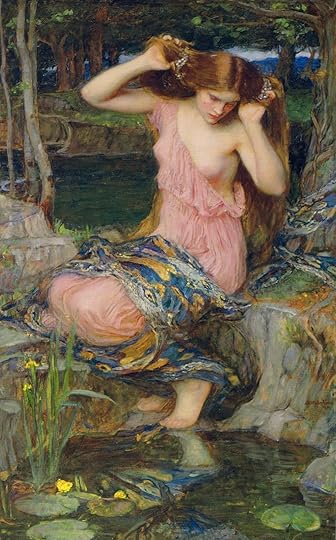 Lamia (2nd version) by John William Waterhouse
Lamia (2nd version) by John William Waterhouse(1909); Note the snakeskin on her lap.Lamia are half-snake, half-woman vampiristic beings from Greek mythology. They eat children and seduce young men. Unlike Medusa, who has hair of snakes, the lamia usually wears snakeskin along her waist and her right forearm, giving hints of her actual characteristics.
According to the Greek mythology, Queen Lamia of Libya had an affair with Zeus. However, Hera found out and killed the children Lamia had already given birth to. Driven mad by this act, Lamia began eating other children and slowly became hideous and corrupt.
Mothers used to tell their children stories of Lamia to warn them of slowly awakening sexuality and to generally make the children behave. Some also used these stories to explain why certain questionable women, and their male companions, were rarely seen after they had met during the night.
Interesting Tidbits:
While both the lamia and Medusa share Greek roots, the lamia is described as more human of the two.In modern stories, Lamia is considered a more remote creature, similar to Baba-Yaga, living in a tower or a house far away from people.Considered magically adept and excelling in deception, lamia were said to have hid among the populace and wreak havoc until finally being hunted down.Have you heard of the Lamia before? If so, where? Also, is there a mythological being you're itching to read about? Let me know!
Published on April 14, 2011 05:17
April 13, 2011
K is for Kraken
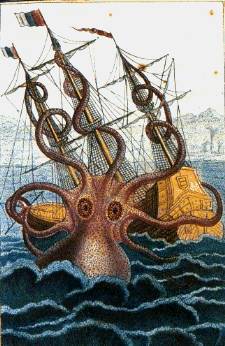 The sea with its vast size has always created stories and lore of its own, ranging from whirlpools the size of small islands to magical creatures and even stories about the ends of the earth. However, few things strike seafarers with as much fear as the Kraken.
The sea with its vast size has always created stories and lore of its own, ranging from whirlpools the size of small islands to magical creatures and even stories about the ends of the earth. However, few things strike seafarers with as much fear as the Kraken.It is a massive squid capable of sinking warships and dragging them to the bottom of the sea, meanwhile creating a whirlpool that sucks down other nearby ships for miles around.
Kraken is viewed as an intelligent force of nature and the embodiment of the raging sea. It is one of the oldest and most often referred sea monsters throughout history. Its origins are tied to the Norway and Iceland, but similar stories of Kraken exists throughout seafaring cultures.
Sure, Kraken sounds like it could merely be a legend of old, but not so, there have been multiple sightings of giant squid across the globe, particularly throughout northern hemisphere and trade routes once used by Vikings. An even larger subspecies of squid, the colossal squid, has been found in the wild and reaches 33ft and possibly longer.
These recent findings suggest that there is something more to this mythological creature than meets the eye, or tentacle. Harr... harr... *grins*
Interesting Tidbits:
It has been the inspiration for a variety of books and movies. Here's a link to some of those. It is usually described as being the size of a floating island and has a flotilla of smaller fish accompanying it, which makes it attractive to fishermen despite the danger. A common saying when one has great catches is, "You must have fished on Kraken."Seaworld Orlando has a roller coaster ride called Kraken. Although, their version is of a huge "dragon eel." Regardless, it's very fun!So, how about you? Have you read a book, seen a movie, or been on a roller coaster ride based off the Kraken?
Published on April 13, 2011 05:05
April 12, 2011
J is for Jötunn
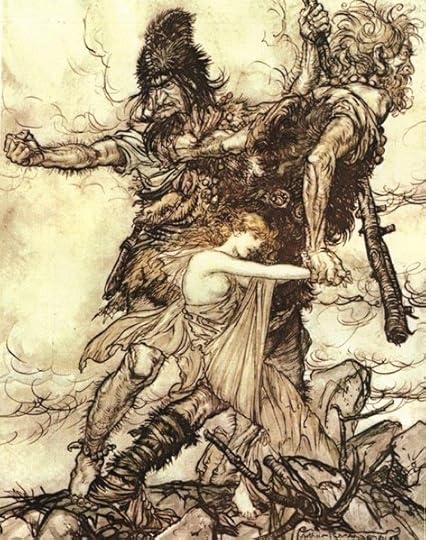 The jötnar Fafner and Fasolt seize Freyja.Jötunn are giants from old Norse mythology. They're extremely strong nature spirits. Their home is Jǫtunheimar, one of the nine worlds in Norse cosmology. They live well with homes fashioned like those of the gods.
The jötnar Fafner and Fasolt seize Freyja.Jötunn are giants from old Norse mythology. They're extremely strong nature spirits. Their home is Jǫtunheimar, one of the nine worlds in Norse cosmology. They live well with homes fashioned like those of the gods.Some jötnar (plural of jötunn) are described as having long claws, fangs, and deformed appearances. As well as being really tall. Others are sometimes given opposite descriptions, except the tall part. While trolls are hideous and have features like those of neanderthals, the jötnar resemble normal people through their general facial features. However, they might have multiple heads (depending on the individual), which can look into different directions.
They also live a long time and can be very knowledgeable and wise. When it comes to magic, they tend to be shamanic and make use of their brute power, allowing it to do most of their work for them. Unlike trolls, the jötnar are unaffected by sunlight and will not turn to stone like their distant cousins. This means that while the majority of populace are safe during the day, shepherds tend to disappear while herding sheep, and thus, naturally are considered to be eaten.
Here is what wikipedia says in regards to their origins:
The first living being formed in the primeval chaos known as Ginnungagap was a giant of monumental size, called Ymir. When he slept a jötunn son and a jötunn daughter grew from his armpits, and his two feet procreated and gave birth to a son, a monster with six heads. These three beings gave rise to the race of hrímþursar (rime thurs), who populated Niflheim, the world of mist, chill and ice. The gods instead claim their origin from a certain Búri. When the giant Ymir subsequently was slain by Odin, Vili and Vé (the grandsons of Búri), his blood (i.e. water) deluged Niflheim and killed all of the jötnar, apart from one known as Bergelmir and his spouse, who then repopulated their kind.Interesting Tidbits:
In Norse mythology, it's said that fire jötnar, or fire giants, will torch the world at the end of Ragnarök, killing all the people, some of the gods, and themselves. All except for a man and a woman Odin sets aside in a forest that doesn't burn.While jötnar are tied to Norway, they have also spread to England, where they are known as Ettin. In later times, trolls began to replace jötnar and took on many of their traits. Due to that, people started viewing them as one in the same.Have you heard of Jötnar before? If so, where? Also, is there a mythological being you're itching to read about? Let me know!
Published on April 12, 2011 04:34
April 10, 2011
I is for Incubus
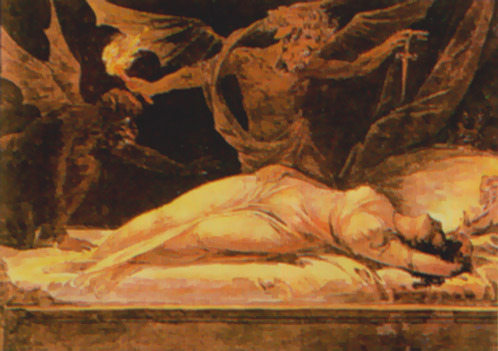 An Incubus is a male demon that comes upon a woman when they're asleep and has intercourse with them, usually with the purpose of trying to impregnate her with his child. According to religious beliefs, continued visits by an incubus lead to the deterioration of one's health and eventually death. It also corrupts both the moral and mental aspects of the female.
An Incubus is a male demon that comes upon a woman when they're asleep and has intercourse with them, usually with the purpose of trying to impregnate her with his child. According to religious beliefs, continued visits by an incubus lead to the deterioration of one's health and eventually death. It also corrupts both the moral and mental aspects of the female.These nighttime visitors were the embodiments of sexual seduction during the medieval times. They were often used to explain pregnancies out of wedlock as well as rape inflicted on the sleeping woman by someone close to the victim. The latter used it as a way to escape punishment for their actions.
The most well-known offspring of an incubus and woman, known as a cambion, is Merlin the powerful wizard from Arthurian legend. Cambion typically grown up to be powerful magic users or evildoers.
Interesting Tidbits:
The word incubus comes from the Latin "incubus," which means "nightmare."Some consider succubi and incubi to be a single demon capable of lying with both genders, while others declare that they are two separate entities.The earliest mention of incubi and succubi are from 2400 BC in ancient Mesopotamian manuscript Sumerian King List. The hero Gilgamesh's father is a "Lilu," which shares the same attributes as an incubus in that they both seduce women while they sleep. What are your thoughts on the Incubi (or Succubi)? Have you experienced any books, movies, or games with them in it?
Published on April 10, 2011 21:00
April 9, 2011
H is for Harpy
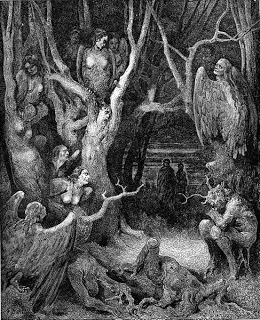 Harpy, from the Greek word harpūia, means "swift robber" or "snatcher." They are personifications of destructive wind. Mostly, they live in areas where the sea is prevalent, specifically the island of Strophades. A harpies appearance includes the head and neck of a woman with the wings, bodies, and talons of a bird. They're cruel, vicious, and very violent.
Harpy, from the Greek word harpūia, means "swift robber" or "snatcher." They are personifications of destructive wind. Mostly, they live in areas where the sea is prevalent, specifically the island of Strophades. A harpies appearance includes the head and neck of a woman with the wings, bodies, and talons of a bird. They're cruel, vicious, and very violent.In tales, harpies fly over their victims, snatch what they want whether it's food or a person, and carry them away from the help of others, or to the underworld, so the harpies can eat. However, if they don't kill their targets, they drive them to the edges of their sanity.
One of the most popular stories featuring harpies is about Phineas. Wikipedia says:
Phineas, a king of Thrace, had the gift of prophecy. Zeus, angry that Phineas revealed too much, punished him by blinding him and putting him on an island with a buffet of food which he could never eat. The harpies always arrived and stole the food out of his hands before he could satisfy his hunger, and befouled the remains of his food. This continued until the arrival of Jason and the Argonauts. The Boreads, sons of Boreas, the North Wind, who also could fly, succeeded in driving off the harpies, but without killing any of them, following a request from Iris, who promised that Phineas would not be bothered by the harpies again, and "the dogs of great Zeus" returned to their "cave in Minoan Crete". Thankful for their help, Phineas told the Argonauts how to pass the Symplegades. (Argonautica, book II; Ovid XIII, 710; Virgil III, 211, 245).Although, they are often compared to sirens, who sink ships by seducing and luring sailors in with their voices, harpies have directly opposite approaches to killing.
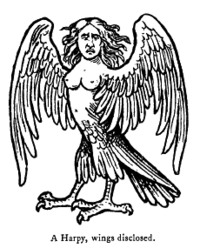 Interesting Tidbit:
Interesting Tidbit:In Dante's Inferno XIII, the second ring of the seventh circle of Hell is for suicides. They are transformed into trees and bushes, which are consumed by harpies.The American Harpy Eagle is an actual bird that appears on Panama's Coat of Arms and is their national bird.Harpies and sirens both became beautiful and seductive later on through Roman romanticism. This has turned the harpy into a more sorrowful spirit of death.Links:http://harpy.info/harpies-in-fictional-literature.htmlhttp://en.wikipedia.org/wiki/Harpyhttp://en.wikisource.org/wiki/1911_Encyclop%C3%A6dia_Britannica/Harpies
Published on April 09, 2011 01:46
April 8, 2011
G is for Gnome
Gnomes are a more recent addition to European folklore. The earliest mentions of them date to the 16th century. Male gnomes wear red pointy caps, have big beards, and usually have a tool belt, which relates to the fact that they're technologically inclined. Female gnomes tend to wear more muted colors, has her hair in braids, and begins to grow a light beard when she reaches 350 years of age. They are very small in size, usually ranging from 5 inches to 2 feet tall depending on the source. Both genders have a very long lifespan.
 German Garden GnomeGnomes are considered more human than their more unluckier cousins and fierce rivals, goblins. Both are viewed as a type of a earth spirit, but gnomes are known as inventors and alchemists, while goblins use crude but effective tools. Gnomes also tend to be capable of earth-related magic.
German Garden GnomeGnomes are considered more human than their more unluckier cousins and fierce rivals, goblins. Both are viewed as a type of a earth spirit, but gnomes are known as inventors and alchemists, while goblins use crude but effective tools. Gnomes also tend to be capable of earth-related magic.
There are several different types of gnomes. Woodland gnomes, Dune gnomes, House gnomes, Farm gnomes, Garden gnomes, and Siberian gnomes. Woodland and Dune gnomes avoid contact with humans. House and Farm are good-natured and more likely to interact with humans. Garden gnomes enjoy living in older gardens and telling depressing stories. The Siberian gnome is meaner and takes revenge for even the smallest of offenses.
Interesting Tidbits:
The origin of the word gnome comes from Latin word gēnomos, which means "earth-dweller." In the 16th Century, a Swiss alchemist named Paracelsus first wrote about gnomus omitting the "ē," which the OED noted was a blunder. The word as we know it today came about in the early 18th century, but it became popular in the 19th century due to their popularity in children's fairy tales.In Scandinavian mythology, they're thought to have always existed but were mostly considered related to other beings, such as fairy or fey.During the 20th century, due to the popularity of 19th century fairy tales, gnomes became synonymous with other domestic spirits, which protected the residence and did household chores, losing their distinctness of being tied to earthy, subterranean lives.Here's a fun video from the video game Fable 3, which features a gnome hurling insults at the main character. It's pretty darn funny.
Who are your favorite Gnomes? What books, movies, or games have you enjoyed with them in it? Has anyone seen the newish movie Gnomeo and Juliet?
 German Garden GnomeGnomes are considered more human than their more unluckier cousins and fierce rivals, goblins. Both are viewed as a type of a earth spirit, but gnomes are known as inventors and alchemists, while goblins use crude but effective tools. Gnomes also tend to be capable of earth-related magic.
German Garden GnomeGnomes are considered more human than their more unluckier cousins and fierce rivals, goblins. Both are viewed as a type of a earth spirit, but gnomes are known as inventors and alchemists, while goblins use crude but effective tools. Gnomes also tend to be capable of earth-related magic.There are several different types of gnomes. Woodland gnomes, Dune gnomes, House gnomes, Farm gnomes, Garden gnomes, and Siberian gnomes. Woodland and Dune gnomes avoid contact with humans. House and Farm are good-natured and more likely to interact with humans. Garden gnomes enjoy living in older gardens and telling depressing stories. The Siberian gnome is meaner and takes revenge for even the smallest of offenses.
Interesting Tidbits:
The origin of the word gnome comes from Latin word gēnomos, which means "earth-dweller." In the 16th Century, a Swiss alchemist named Paracelsus first wrote about gnomus omitting the "ē," which the OED noted was a blunder. The word as we know it today came about in the early 18th century, but it became popular in the 19th century due to their popularity in children's fairy tales.In Scandinavian mythology, they're thought to have always existed but were mostly considered related to other beings, such as fairy or fey.During the 20th century, due to the popularity of 19th century fairy tales, gnomes became synonymous with other domestic spirits, which protected the residence and did household chores, losing their distinctness of being tied to earthy, subterranean lives.Here's a fun video from the video game Fable 3, which features a gnome hurling insults at the main character. It's pretty darn funny.
Who are your favorite Gnomes? What books, movies, or games have you enjoyed with them in it? Has anyone seen the newish movie Gnomeo and Juliet?
Published on April 08, 2011 02:04
April 7, 2011
F is for Furies
The Furies, or Dirae, are part of Roman mythology. In Greek mythology, they're called Erinnýes ("the angry ones") or Eumenídes ("the Kindly Ones"). They're the embodiments of vengeance. One description of their existence is that they came from the blood of Caelus (Greek: Uranus) when it fell upon Terra Mater (Gaia) due to Saturn (Cronus) castrating him. Another variation is that they were born from the primordial goddess of night, Nox (Nyx).
While typically thought of as three sisters, according to mythology, the real number of them are unknown. Virgil, the classical Roman poet, was first to recognize the three known Furies. Their names are Alecto (which means "unceasing"), Megaera ("grudging"), and Tisiphone ("avenging murder"). They tend to appear as women with serpent wreathes on their heads, blood running from their eyes and the wings of a bat or bird. And occasionally even the body of a dog.
When they're not pursuing wrongdoers on Earth, the Furies are thought to spend most of their time in Tartarus, which is in the underworld below Hades, torturing damned souls.
 'Orestes Pursued by the Furies' (1921) by John Singer SargentInteresting Tidbits:
'Orestes Pursued by the Furies' (1921) by John Singer SargentInteresting Tidbits:
On a rare few occasions, they would be called to punish a god, but mostly, they sought justice on mortals who broke laws such as murdering kin or breaking oaths.A common Greek story featuring the Furies is "Eumenides" by Aeschylus. The Furies torment Orestes until he begs the goddess Athena to convince the Furies to leave him alone.The Furies are known to be just, so if one repents, they will stop tormenting the person and sometimes bestow upon them blessings.Good links to check out for more information:http://www.furies.net/http://en.wikipedia.org/wiki/Furieshttp://www.pantheon.org/articles/f/furies.htmlhttp://www.knowledgerush.com/kr/encyclopedia/Dirae/What are your thoughts on the Furies? Have you experienced any books, movies, or games with them in it?
While typically thought of as three sisters, according to mythology, the real number of them are unknown. Virgil, the classical Roman poet, was first to recognize the three known Furies. Their names are Alecto (which means "unceasing"), Megaera ("grudging"), and Tisiphone ("avenging murder"). They tend to appear as women with serpent wreathes on their heads, blood running from their eyes and the wings of a bat or bird. And occasionally even the body of a dog.
When they're not pursuing wrongdoers on Earth, the Furies are thought to spend most of their time in Tartarus, which is in the underworld below Hades, torturing damned souls.
 'Orestes Pursued by the Furies' (1921) by John Singer SargentInteresting Tidbits:
'Orestes Pursued by the Furies' (1921) by John Singer SargentInteresting Tidbits:On a rare few occasions, they would be called to punish a god, but mostly, they sought justice on mortals who broke laws such as murdering kin or breaking oaths.A common Greek story featuring the Furies is "Eumenides" by Aeschylus. The Furies torment Orestes until he begs the goddess Athena to convince the Furies to leave him alone.The Furies are known to be just, so if one repents, they will stop tormenting the person and sometimes bestow upon them blessings.Good links to check out for more information:http://www.furies.net/http://en.wikipedia.org/wiki/Furieshttp://www.pantheon.org/articles/f/furies.htmlhttp://www.knowledgerush.com/kr/encyclopedia/Dirae/What are your thoughts on the Furies? Have you experienced any books, movies, or games with them in it?
Published on April 07, 2011 00:21



